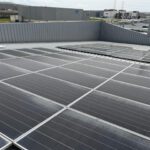New Contact Plating Processes Cut Costs, Improve Environmental Impacts
The RoHS and REACH directives, along with rising material costs, have led to innovative new processes and materials for contact plating.
In the world of electronics design, great challenges lead to great innovation. Take the Restriction of Hazardous Substances (RoHS) and Reach directives, for example. These European environmental directives disrupted decades of common processes and chemicals used in electronics manufacturing. The goal of these directives — to reduce the amounts of toxic substances released into the environment by electronics production and disposal methods — seemed to be at odds with the industry’s performance and cost objectives. However, connector manufacturers and their suppliers have devised an innovative range of materials solutions that have enabled the connector industry to provide powerful, cost-effective, and safer components. Plating is one area that has seen significant development in recent years.
Plating is the application of a very thin layer of metal over a part made from another type of metal or plastic. In the connector world, plating may be used on housings to protect the metal from corrosion, but it is commonly used on pins and contacts. This process gives the contact the properties of the plating metal without the expense of a solid contact. “The type of plating material used directly correlates to the performance characteristics of a connector contact,” said Mike Conte, general manager, SOS Engineering, Inc., a supplier of precision contacts and connectors. “Materials are chosen for several performance characteristics, including corrosion resistance, electrical conductivity, thermal conductivity, solderability, wear resistance, operational life, and infrared reflectivity.”
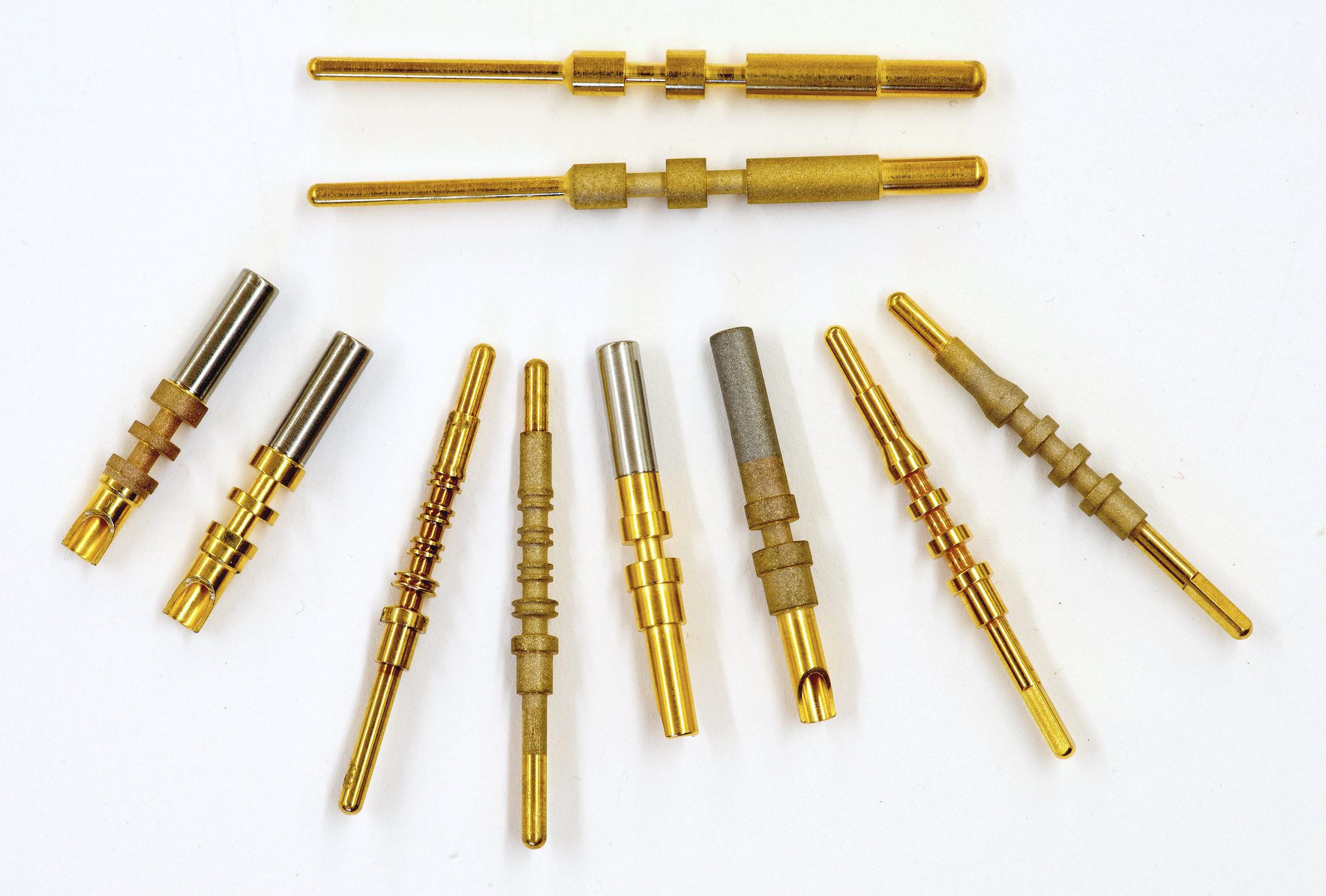
SOS Engineering makes connector contacts out of a full range of materials, including copper alloys, stainless steel, alumel, chromel, and plastics. Selective plating helps minimize costs while achieving high performance.
Plating can increase ruggedness and signal reliability. Additionally, a plating applied to a base contact combines the advantages of both metals. For example, copper is favored for its superior conductivity, but it is prone to oxidation; plating with gold or another tarnish-resistant metal improves the contact’s corrosion resistance. With today’s high-precision plating processes, as little as .125 microns (.000005″) of a material can be applied to a base metal. Gold, copper, zinc, palladium, nickel, silver, and alloys are among the metals used for plating, although, “the thicker the gold-plated layer, the more durable and resistant to temperature and corrosion the contact becomes,” said Conte.
Under RoHS/REACH, connector manufacturers have looked for safer alternatives to the use of lead, mercury, cadmium, and hexavalent chromium in platings, as these substances pose a risk to human health and development. In response to calls for safer materials, Amphenol Aerospace developed its AP-93 plating. “We have been surmounting environmental challenges for our customers for decades and many new plating products were developed as a result of those efforts and are popular today,” said Anthony Annunziata, head of research and development and senior manager, new product introduction, for Amphenol Aerospace. “However, their flexibility for adoption has always been limited by their backwards compatibility. Military hardware upgrades being developed today are under enormous pressure to utilize existing inventory as much as possible, and that often means taking advantage of existing cable inventory. Changes to REACH-compliant connectors on the panel are great but are often untenable if they render plugs on the existing cables obsolete.”

Amphenol Aerospace’s AP-93 plating is a conductive REACH/RoHS-compliant finish which outperforms cadmium. AP-93 exceeds olive-drab cadmium plating (Class W) by meeting 1,000 hours of dynamic salt spray, 500 mating cycles, and meets the millivolt drop shell-to-shell conductivity of nickel (Class F). AP-93 also meets a 200°C temperature rating and is compatible with other platings.
When Amphenol Aerospace began its development program in 2017, the company was on the hunt for the “holy grail” of electroplated finishes, said Annunziata. “We saw the writing on the wall for the inclusion of dangerous ingredients like cadmium and hexavalent chromium, but at the same time we faced more challenging environmental requirements, such as demand for products that last longer in sodium chloride- and sulfur dioxide-laden atmospheres. So, we set out – as a key element of the design – to ensure mateability with all popular aluminum finishes; OD Cad, black zinc nickel, electroless nickel, etc., and that was really the driving philosophy and primary struggle of our development. Once we succeeded at that, we decided that instead of declaring victory and releasing the product, we’d keep fine-tuning the formula and see what sorts of ancillary benefits we could achieve – 1,000-hour salt-spray capable, scratch-resistant, 200°C-rated, great marking adhesion, etc. Now we’re excited to aid the advancement of the (olive drab) green revolution.”
Lemco Précision SA is another company that developed a new plating material for customers. “Due to the COVID pandemic, connector suppliers have seen significant increases in gold prices, which led to higher prices for screw-cutting of contacts, so companies turned to cost-effective alternatives to gold, such as palladium. However, the sudden increase in demand for palladium pushed those prices up too,” said Davut Orman, applications engineering, innovation & diversification manager, Lemco Précision. “Our SWISSCOAT coating system was developed to help clients mitigate their costs. Our aim was to find a balance between the use of noble metals and costs optimization without sacrificing high quality and resistance.
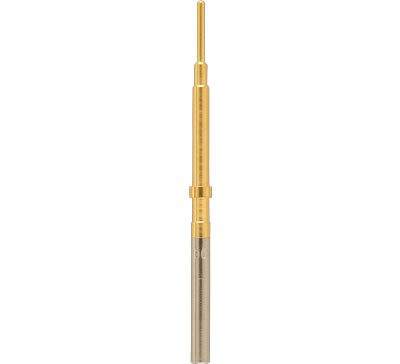
Lemco Précision’s SWISSCOATTM is a galvanic multilayer with a gold finish. It offers similar properties to regular gold-plating, conforms to MIL-C-45204 TYPE II Grade C Class 1, and reduces costs by up to 20% compared to regular gold.
Cost Reduction Through Selective Plating
Strategic plating application and selection also reduces the cost impact of component manufacturing. In selective plating, a more rare or expensive plating material such as gold, platinum, or palladium is applied to only part of the contact. Precise application methods even enable plating specialists to apply varying thicknesses of plating to different parts of a contact.
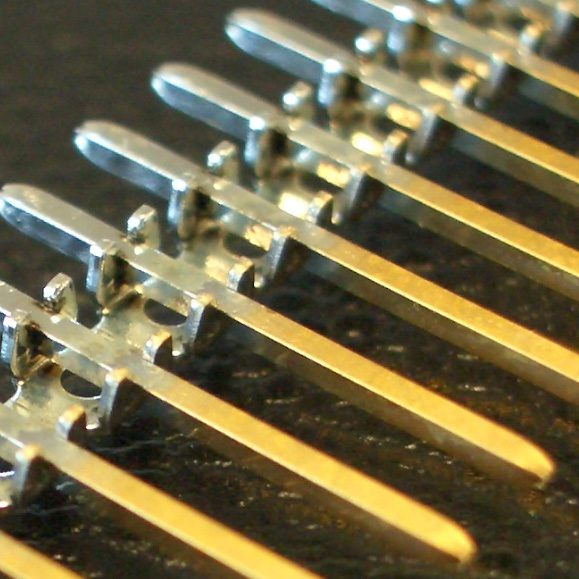
The Besi plating group of Meco Equipment Engineers manufactures and supplies selective plating equipment to suit a wide variety of products and finishes.
“In general, copper and nickel finishes are usually applied by all over plating. The more precious metals, like gold or palladium, are selectively plated on only the functional areas of the connector using techniques like control depth plating, stripe plating, spot plating, front and rear side plating, or contour plating. Finally, the solder finish area of the connector is plated by control depth plating, stripe plating, or spot plating,” said Jelle Jüngeling, product manager, connector plating, Besi/Meco Equipment Engineers, a company that manufactures selective plating equipment for connectors, solar cells, and other electronics, including components used in quantum computers through the MATQu project.

Manufactured as inlayed clad stripes in copper spring alloys, Materion’s iON connector plating has a fully dense structure that provide durability for high-temperature and corrosion-resistant contacts.
Materion offers overall electroplating of microelectronics and ceramics as well as selective plating in layers, in a conductive stripe, in precision applications on parts of a component, or other configurations. “We work closely with connector manufacturers to address challenges such as high vibration, high current, high temperature, and cost with selective plating and spot plating lines that enable precision placement of precious metals to produce high quality components,” said Mike Gedeon, customer technical services manager at Materion, a company that provides high-performance material solutions for component suppliers. When performance requirements stretch the limits of what electroplating can offer, we recommend our iON Connector solutions for harsh environments. iON connector materials are engineered alternatives to electroplated contact surfaces with contacts that are metallurgically clad into the connector.”
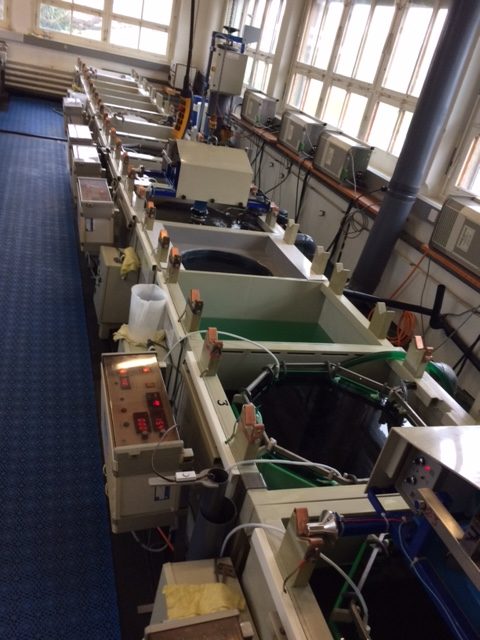
Plating involves a series of steps as components move from one processing station to the next. (Image courtesy of Lemco Précision.)
As sustainability, cost, accessibility, and performance continue to challenge component suppliers and OEMs, new material solutions and new machining and plating processes provide the solutions the industry needs to produce highly effective products.
Like this article? Check out our other Manufacturing, Contacts and Innovation articles, our Materials Market Page, and our 2022 and 2021 Article Archives.
Subscribe to our weekly e-newsletters, follow us on LinkedIn, Twitter, and Facebook, and check out our eBook archives for more applicable, expert-informed connectivity content.
- Where in the World is Amphenol LTW’s Luc Kan? - April 23, 2024
- TE Connectivity’s Sustainability Efforts Pay Off - April 23, 2024
- What is a VGA Connector? - April 23, 2024

